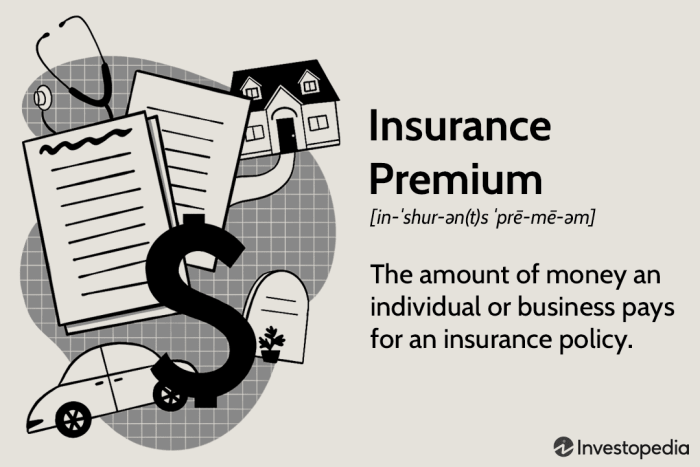Understanding insurance premiums is crucial for navigating the world of financial protection. This guide delves into the multifaceted nature of insurance premiums, exploring how they are calculated, the factors influencing their cost, and the various payment options available. We’ll unravel the complexities of premium structures across different insurance types, empowering you to make informed decisions about your financial security.
From the fundamental definition of a premium to its intricate relationship with policy coverage and personal financial planning, we aim to provide a clear and comprehensive understanding. We’ll examine how your choices – from payment schedules to coverage levels – directly impact your premium costs and the overall value you receive from your insurance policy.
Defining “Premium” in the Insurance Context

In the world of insurance, the “premium” is the price you pay to an insurance company in exchange for financial protection against potential losses. It’s essentially your contribution to the risk pool that allows the insurer to pay out claims to those who experience covered events. Understanding premiums is crucial for making informed decisions about your insurance coverage.
Premium Calculation: A Detailed Breakdown
Premiums aren’t arbitrarily assigned; they are calculated based on a complex formula that considers numerous factors. The fundamental principle involves assessing the likelihood of a claim and the potential cost of that claim. Insurers use actuarial science, statistical modeling, and vast amounts of data to determine the appropriate premium for each individual or policy. A simplified representation of this process could be: Premium = (Expected Claims Cost + Administrative Expenses + Profit Margin) / Number of Policyholders. This formula is, however, a significant oversimplification of a much more nuanced calculation. The actual calculation incorporates far more detailed and sophisticated methodologies.
Factors Influencing Premium Amounts
Several factors influence premium amounts across different insurance types. These vary widely depending on the specific risk profile associated with each policy.
Car Insurance Premiums
For car insurance, factors like your driving history (accidents, tickets), age, location (urban areas tend to have higher rates due to increased risk), vehicle type (sports cars are generally more expensive to insure), and coverage level (comprehensive vs. liability) all play a significant role in determining your premium. For example, a young driver with a poor driving record living in a large city will likely pay substantially more than an older driver with a clean record living in a rural area, even if they both drive the same car.
Health Insurance Premiums
Health insurance premiums are influenced by factors such as age, location, pre-existing conditions, the type of plan (e.g., HMO, PPO), and the level of coverage. Individuals with pre-existing conditions generally pay higher premiums, reflecting the increased likelihood of claims. Similarly, those in areas with higher healthcare costs will also see higher premiums. Family plans typically cost more than individual plans.
Life Insurance Premiums
Life insurance premiums are largely determined by factors such as age, health status (medical history, lifestyle choices like smoking), the type of policy (term life, whole life), and the death benefit amount. Younger, healthier individuals will generally receive lower premiums than older individuals with health issues. A larger death benefit will also result in a higher premium.
Premium Structure Comparison: Sample Auto Insurance
The following table illustrates a comparison of premium structures across three hypothetical auto insurance providers for a standard liability policy for a 35-year-old driver with a clean driving record in a mid-sized city driving a sedan. These are illustrative examples and actual premiums vary widely based on numerous factors.
| Insurance Provider | Annual Premium | Deductible | Coverage Limits |
|---|---|---|---|
| Provider A | $800 | $500 | $100,000/$300,000 |
| Provider B | $950 | $250 | $100,000/$300,000 |
| Provider C | $750 | $1000 | $100,000/$300,000 |
Premium Payment Methods and Schedules

Choosing how to pay your insurance premiums is an important decision that impacts your budget and your policy’s standing. The frequency of payments, along with the method used, can affect the overall cost and convenience of maintaining your insurance coverage. Understanding the various options available allows for informed decision-making tailored to individual financial situations.
Common Premium Payment Methods
Insurance premiums can typically be paid through several convenient methods. The most common include electronic bank transfers (ACH), credit or debit card payments, and traditional checks or money orders mailed to the insurance provider. Some companies also offer payment options through online bill pay services or dedicated mobile apps. Each method offers varying degrees of convenience and potential fees.
Payment Schedules and Their Implications
Insurance companies generally offer several payment schedules for premiums: annually, semi-annually (every six months), quarterly (every three months), and monthly. The choice of schedule significantly impacts cash flow management. Paying annually usually results in a small discount, reflecting the insurer’s administrative savings. Conversely, monthly payments offer greater flexibility but often come with a slightly higher overall cost due to the increased processing fees.
Advantages and Disadvantages of Different Payment Methods
A comparison of common payment methods and schedules reveals a trade-off between cost and convenience:
| Payment Method | Advantages | Disadvantages |
|---|---|---|
| Annual Payment | Lowest overall cost (often with a discount), convenient for budgeting | Requires a larger upfront payment, less flexibility for unexpected expenses |
| Semi-Annual Payment | Balances cost and convenience, manageable payments | Slightly higher cost than annual payment |
| Quarterly Payment | More frequent payments than semi-annual, better cash flow management | Higher cost than semi-annual and annual payments |
| Monthly Payment | Most flexible payment option, easiest on budget | Highest overall cost due to administrative fees |
| Electronic Bank Transfer (ACH) | Convenient, automated, usually free | Requires bank account setup |
| Credit/Debit Card | Convenient, widely accepted | May incur transaction fees, potential for late payment fees if not properly scheduled |
| Check/Money Order | Traditional method, no transaction fees (usually) | Less convenient, requires mailing, risk of lost mail |
Potential Penalties for Late Premium Payments
Late premium payments can have significant consequences. Understanding these penalties is crucial for responsible insurance management.
The following are potential penalties for late payments:
- Late Payment Fees: Most insurers charge a late fee, typically a percentage of the missed payment or a flat fee.
- Policy Cancellation: If premiums remain unpaid after a grace period (usually 30 days), the insurance policy may be cancelled.
- Impact on Credit Score: Repeated late payments can negatively affect your credit score, making it harder to obtain loans or other financial products in the future.
- Loss of Coverage: Once your policy is cancelled, you’ll lose coverage, leaving you vulnerable to financial hardship in case of an accident or other covered event.
- Reinstatement Fees: If you wish to reinstate your cancelled policy, you may be required to pay reinstatement fees in addition to the overdue premiums.
Premium as a Financial Consideration
Insurance premiums are a significant financial commitment for most individuals and businesses. Understanding their affordability, incorporating them into financial planning, and developing effective management strategies are crucial for responsible financial management. Failure to adequately address these aspects can lead to financial strain and potential gaps in crucial insurance coverage.
Premium Affordability and Consumer Choices
Premium affordability significantly influences consumer choices regarding insurance coverage. High premiums can deter individuals from purchasing necessary insurance, leaving them vulnerable to financial hardship in the event of unforeseen circumstances. Conversely, affordable premiums encourage greater insurance uptake, leading to better financial protection. Consumers often balance the cost of premiums against the potential financial risks they face, seeking to find a balance between adequate coverage and manageable expenses. This often involves comparing policies from different insurers and carefully considering the level of coverage needed versus the associated cost. For example, a young, healthy individual might opt for a higher deductible on their health insurance to lower their monthly premium, while a family with young children might prioritize comprehensive coverage despite higher premiums.
The Role of Insurance Premiums in Personal Financial Planning
Insurance premiums are a recurring expense that should be integrated into a comprehensive personal financial plan. They represent a proactive approach to risk management, safeguarding against potential financial losses from accidents, illnesses, or other unforeseen events. Budgeting for premiums ensures that adequate funds are available to meet these obligations without jeopardizing other financial goals, such as saving for retirement or paying off debt. Failure to account for premiums in a financial plan can lead to unexpected financial strain and may force individuals to compromise on other essential financial priorities. A well-structured financial plan will allocate a specific amount for insurance premiums each month or year, ensuring consistent payments and preventing late fees or policy cancellations.
Strategies for Managing Insurance Premiums Effectively
Several strategies can be employed to manage insurance premiums effectively. These include comparing quotes from multiple insurers, increasing deductibles (where appropriate), bundling policies (home and auto, for example), maintaining a good driving record (for auto insurance), and engaging in healthy lifestyle choices (for health insurance). Regularly reviewing coverage needs and adjusting policies accordingly can also help control premium costs. For instance, once children leave home, a homeowner might find they need less liability coverage, resulting in lower premiums. Exploring different payment options, such as paying annually instead of monthly, may also offer potential savings. Finally, maintaining open communication with insurance providers and proactively addressing any concerns can help prevent unexpected premium increases.
Illustrative Examples of Budgeting for Insurance Premiums
Consider a young professional with a monthly budget of $3000. They allocate $200 for auto insurance, $150 for renters insurance, and $300 for health insurance, totaling $650 monthly. This leaves $2350 for other expenses like rent, food, and entertainment. Alternatively, a family with two children might allocate $1000 per month for insurance, covering health, auto, home, and life insurance. Their total monthly budget might be $6000, leaving $5000 for other essential expenses. These examples illustrate how different individuals and families can incorporate insurance premiums into their budgets based on their specific needs and financial situations. Careful budgeting ensures that insurance premiums do not become an undue financial burden, allowing for financial stability and peace of mind.
Final Wrap-Up

In conclusion, mastering the concept of insurance premiums is a cornerstone of effective financial planning. By understanding the factors that influence premium costs, the available payment options, and the connection between premiums and coverage, you can make well-informed decisions that align with your individual needs and budget. Remember, a thorough understanding of your insurance premiums ensures you receive the optimal level of protection without unnecessary financial strain.
FAQ Resource
What happens if I miss a premium payment?
Consequences vary by insurer but can include late fees, suspension of coverage, or policy cancellation.
Can I negotiate my insurance premium?
While not always possible, you can often negotiate by bundling policies, improving your credit score, or shopping around for better rates.
How often are premiums typically reviewed?
Review frequency depends on the insurer and policy type, but it’s common for premiums to be reassessed annually or at renewal.
Does my driving record affect my car insurance premium?
Yes, a poor driving record with accidents or violations significantly increases car insurance premiums.
What is the difference between a deductible and a premium?
A premium is the regular payment for insurance coverage; a deductible is the amount you pay out-of-pocket before insurance coverage begins.